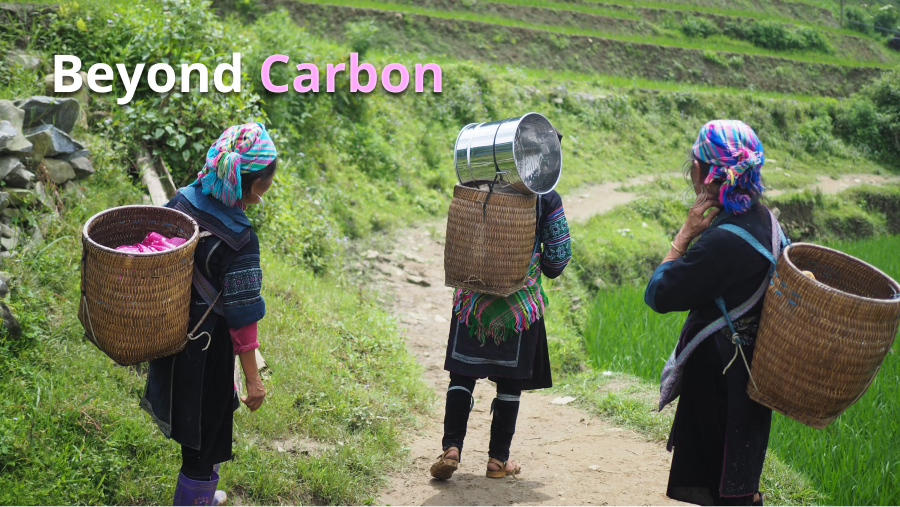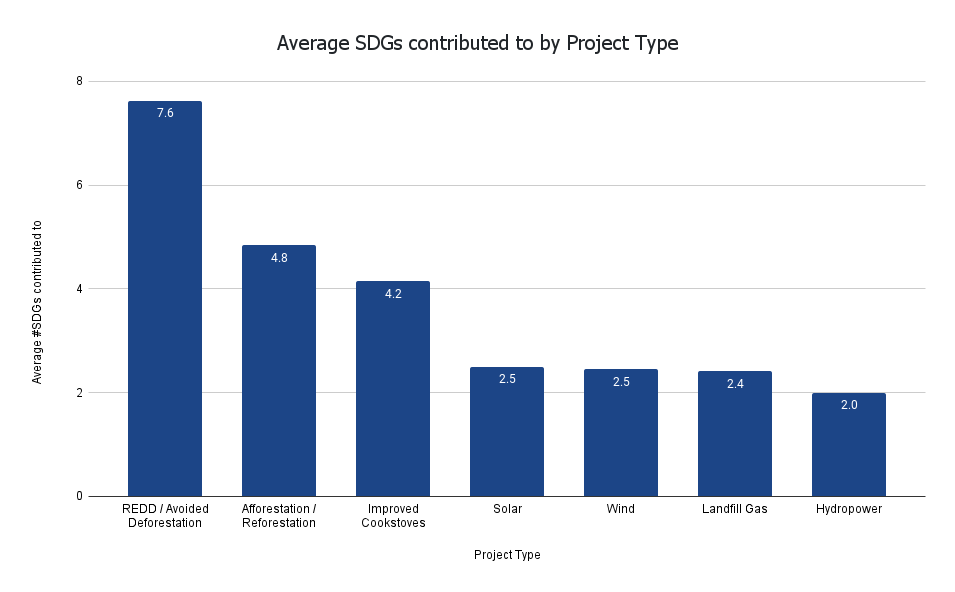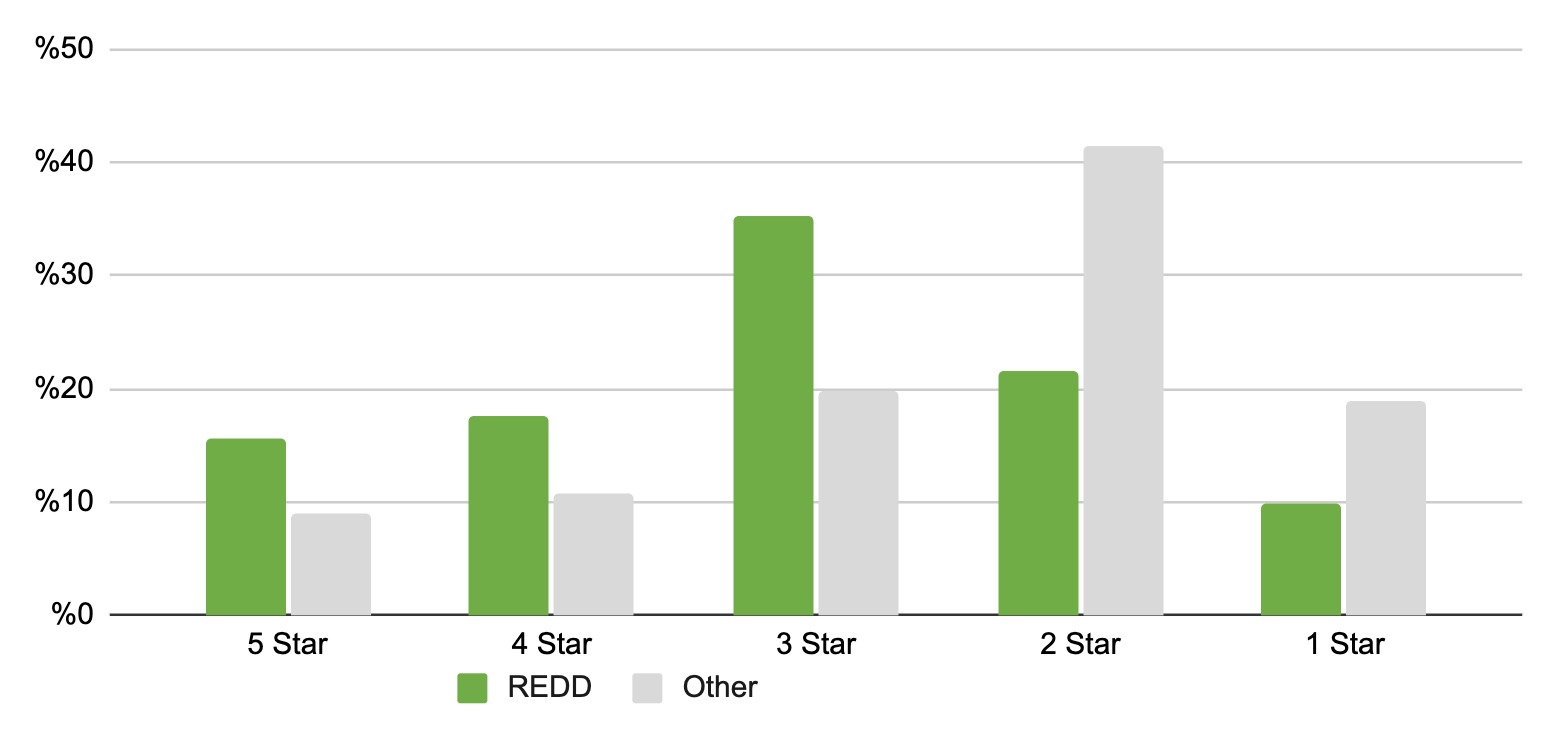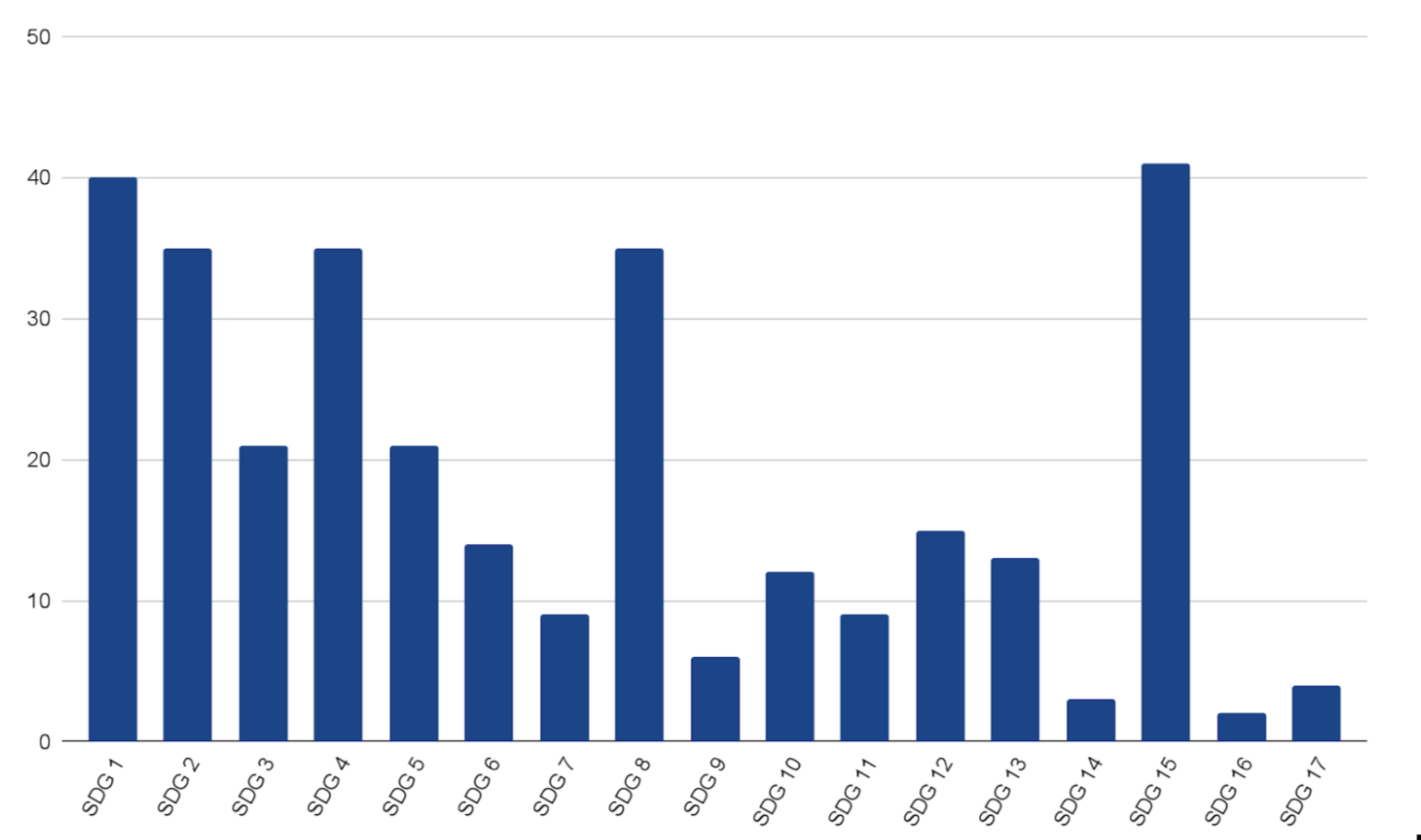
REDD projects have recently been in the media due to challenges related to overcrediting. Calyx Global recognizes that REDD projects indeed face such challenges, and will soon publish our findings after assessing over 70 such projects. It will include a set of recommendations on how to improve the GHG integrity of REDD projects.
This blog, however, delves into how REDD projects provide benefits beyond carbon, also known as "co-benefits". REDD projects can play an important role in promoting and contributing to sustainable development, especially in developing countries.
Our analysis reflects lessons learned from rating the SDG impact of over 200 projects, including 51 REDD projects.
In order for claimed SDG contributions to be rated by Calyx Global, a project must be certified for co-benefits by, for example, Verra’s Climate, Community and Biodiversity (CCB) and Sustainable Development Verified Impact standards (SDVista) or the Gold Standard for the Global Goals (GS4GG). This is because we believe it is important for SDG contributions to go through a process of validation, monitoring, and verification by an independent third party.
Not all carbon projects are certified for SDG contributions. Of the over 40001 projects that have sold credits into the voluntary market, less than a third have SDG certification2. Gold Standard is the only carbon crediting program that requires projects to demonstrate contributions to SDGs.
REDD projects make more contributions to SDGs than other project types. On average, REDD projects make over seven SDG contributions per project. By comparison, other types of projects (such as landfill gas or renewable energy) make on average just three contributions per project.
Figure: Average number of SDG contributions per project, by project type
Note: Based on projects rated to date by Calyx Global

REDD projects tend to have a higher SDG rating from Calyx Global. Our SDG ratings aggregate a project’s contributions through a scoring system that includes the number of contributions, as well as their depth. One can see from the figure below, which shows the percentage of projects with one to five star ratings from Calyx Global, that REDD performs better than other project types. REDD projects provide over 90% of our 5-star projects - our highest rating. The reason behind this is due to the number, variety and quality of reporting of project contributions to the SDGs.
Figure: Percentage of certified projects with various Calyx Global SDG ratings

In our analysis of 51 REDD projects, we have found that many of these projects positively impact biodiversity and community development, which can in turn contribute to a wide range of SDG targets (there are 17 SDGs and under each SDG are multiple “targets”). It is worth noting that REDD projects are diverse in terms of claimed and reported contributions to SDGs. The number and variety of SDG contributions may depend, for example, on the ability of REDD project developers to identify and address local development needs, or the location of projects, i.e. whether they are located in areas with high conservation value for biodiversity. Some projects foresee a wider variety of activities due to the diverse pressures to which local forests are subjected. Larger projects generally address more drivers of deforestation, and hence engage a wider range of SDG beneficiaries.
Figure 1 below shows the main SDG contributions claimed. Not surprisingly, the top SDG contribution claimed is enhancing biodiversity, a target under SDG 15: Life on Land. The second highest is SDG 1: Poverty Reduction. This is followed by SDGs 2: Zero hunger, SDG 4: Quality Education and SDG 8: Decent work and Economic Growth.
Figure: Distribution of SDG claims across 51 REDD projects rated by Calyx Global.

The top SDG contributions by REDD projects are summarized below.
Enhancing Biodiversity (SDG 15): REDD projects have goals that go hand in hand with this target, which urges countries to take action to reduce the degradation of natural habitats, halt the loss of biodiversity, and protect and prevent the extinction of threatened species. By design, all CCB projects are expected to contribute to this target. In this context, our data shows that some of the highest quality reporting on biodiversity contributions have been encountered in CCB-certified REDD projects.
An example of a highly-rated SDG contribution by Calyx Global is a project that reported measures to protect biodiversity and reduced the risk of human-wildlife conflict. These conservation measures include daily forest patrols for wildlife monitoring and the drilling of wildlife-only water boreholes. Through continued monitoring and implementation of conservation activities, the developer was able to report the increased observance of three critically endangered mammal species, in addition to several other animals in the project area.
Poverty Reduction (SDG 1): Our assessments also indicate that REDD projects often have a positive impact on reducing poverty. One way this is done is through the provision of financial incentives to forest owners via benefit-sharing agreements. It is important to note that benefit-sharing arrangements vary in effectiveness, quality and local endorsement. Nonetheless, some projects have reported, with sufficient depth and quality, an increase in household income and an overall improvement of livelihoods as a result of these mechanisms.
In addition, some REDD projects have facilitated the establishment of small-scale enterprises in communities and made additional efforts to enhance market access for these enterprises. This has led to significant revenue generation for these communities, which has also contributed to poverty reduction. Furthermore, some REDD projects have trained community members on land management, territorial appropriation, and governance. This resulted in the strengthening of land tenure security and local institutions, contributing to the overall reduction of poverty.
Improving food security (SDG 2): The Director-General of the Food and Agriculture Organization of the United Nations pointed out in 2019: "It is possible to reconcile food security, agricultural production and forest conservation."3 A good example of this is agroforestry activities often implemented by REDD projects. One of the main contributions seen in our assessments is related to SDG target 2.3: Increase agricultural productivity and incomes of small-scale food producers. For example, REDD projects have trained farmers in sustainable agricultural production, which generates tangible changes in hectares of private agricultural land established with sustainable practices, which in turn generates impacts that go beyond increased agricultural production, such as disease control and community participation in the development of the commodity value chain.
Job Provision (SDG 8): One of the lesser-known advantages of REDD projects is their potential to generate employment opportunities for rural communities. REDD initiatives are typically situated in remote regions with limited job opportunities for local residents, where existing employment is frequently poorly compensated, sporadic, and often reliant on farming practices that endanger forests and contribute to land-use change.4 According to a report released in 2022, policies aimed at promoting Nature-based Solutions have the potential to generate numerous employment opportunities, with a particular emphasis on benefiting individuals residing in rural communities.5 Calyx Global’s assessment supports this assertion. We have found that REDD projects, if designed well, offer job opportunities to individuals within the project areas.
Ensure inclusive and equitable education (SDG 4): Some REDD projects have been instrumental in supporting educational development of forest communities in remote and underserved areas. Utilizing the revenue generated from carbon credits, these projects have established essential infrastructure and improved access to quality education in the form of scholarships and educational bursaries to the most needy communities.6 Calyx Global’s assessment highlights that some of these REDD projects have gone the extra mile to improve the level of education of these communities. For instance, some projects have built new schools, libraries, or improved school building facilities. Scholarships have also been awarded - particularly to young people - enabling them to graduate or receive an academic degree. The implementation of these activities has resulted in local community improvements that would not have been possible without the REDD project's intervention.
While we are highlighting in this blog the positive benefits that REDD projects provide, we also note the importance of project implementers’ ability to address and mitigate potential environmental risks that the project may pose. The success of the positive impacts will be contingent on adequate risk management, including ensuring stakeholder participation and respect for human rights.
Many REDD projects have proven the ability to provide significant benefits to communities and biodiversity. Such projects can be an effective channel of finance for contributing to the United Nations Sustainable Development Goals.
However, currently, many buyers are put in the uncomfortable position of trading off GHG integrity for SDG impact. Our upcoming report on REDD focuses on the GHG integrity of such projects – and will provide recommendations on how REDD projects can improve their emission reduction claims. Doing so will, ideally, create a win-win – for the protection of critical forest resources that reduce emissions, while also improving people’s lives.
This blog, however, delves into how REDD projects provide benefits beyond carbon, also known as "co-benefits". REDD projects can play an important role in promoting and contributing to sustainable development, especially in developing countries.
Our analysis reflects lessons learned from rating the SDG impact of over 200 projects, including 51 REDD projects.
Calyx SDG Ratings
Calyx Sustainable Development Goals (SDG) ratings are an assessment of the level of change and the quality of evidence provided by projects that are certified. For more information on our SDG ratings, see Calyx Ratings Explained.In order for claimed SDG contributions to be rated by Calyx Global, a project must be certified for co-benefits by, for example, Verra’s Climate, Community and Biodiversity (CCB) and Sustainable Development Verified Impact standards (SDVista) or the Gold Standard for the Global Goals (GS4GG). This is because we believe it is important for SDG contributions to go through a process of validation, monitoring, and verification by an independent third party.
How do REDD projects perform compared to other project types?
Not all carbon projects are certified for SDG contributions. Of the over 40001 projects that have sold credits into the voluntary market, less than a third have SDG certification2. Gold Standard is the only carbon crediting program that requires projects to demonstrate contributions to SDGs.REDD projects make more contributions to SDGs than other project types. On average, REDD projects make over seven SDG contributions per project. By comparison, other types of projects (such as landfill gas or renewable energy) make on average just three contributions per project.
Figure: Average number of SDG contributions per project, by project type
Note: Based on projects rated to date by Calyx Global

REDD projects tend to have a higher SDG rating from Calyx Global. Our SDG ratings aggregate a project’s contributions through a scoring system that includes the number of contributions, as well as their depth. One can see from the figure below, which shows the percentage of projects with one to five star ratings from Calyx Global, that REDD performs better than other project types. REDD projects provide over 90% of our 5-star projects - our highest rating. The reason behind this is due to the number, variety and quality of reporting of project contributions to the SDGs.
Figure: Percentage of certified projects with various Calyx Global SDG ratings

How REDD projects contribute towards sustainable development
In our analysis of 51 REDD projects, we have found that many of these projects positively impact biodiversity and community development, which can in turn contribute to a wide range of SDG targets (there are 17 SDGs and under each SDG are multiple “targets”). It is worth noting that REDD projects are diverse in terms of claimed and reported contributions to SDGs. The number and variety of SDG contributions may depend, for example, on the ability of REDD project developers to identify and address local development needs, or the location of projects, i.e. whether they are located in areas with high conservation value for biodiversity. Some projects foresee a wider variety of activities due to the diverse pressures to which local forests are subjected. Larger projects generally address more drivers of deforestation, and hence engage a wider range of SDG beneficiaries.Figure 1 below shows the main SDG contributions claimed. Not surprisingly, the top SDG contribution claimed is enhancing biodiversity, a target under SDG 15: Life on Land. The second highest is SDG 1: Poverty Reduction. This is followed by SDGs 2: Zero hunger, SDG 4: Quality Education and SDG 8: Decent work and Economic Growth.
Figure: Distribution of SDG claims across 51 REDD projects rated by Calyx Global.

The top SDG contributions by REDD projects are summarized below.
Enhancing Biodiversity (SDG 15): REDD projects have goals that go hand in hand with this target, which urges countries to take action to reduce the degradation of natural habitats, halt the loss of biodiversity, and protect and prevent the extinction of threatened species. By design, all CCB projects are expected to contribute to this target. In this context, our data shows that some of the highest quality reporting on biodiversity contributions have been encountered in CCB-certified REDD projects.
An example of a highly-rated SDG contribution by Calyx Global is a project that reported measures to protect biodiversity and reduced the risk of human-wildlife conflict. These conservation measures include daily forest patrols for wildlife monitoring and the drilling of wildlife-only water boreholes. Through continued monitoring and implementation of conservation activities, the developer was able to report the increased observance of three critically endangered mammal species, in addition to several other animals in the project area.
Poverty Reduction (SDG 1): Our assessments also indicate that REDD projects often have a positive impact on reducing poverty. One way this is done is through the provision of financial incentives to forest owners via benefit-sharing agreements. It is important to note that benefit-sharing arrangements vary in effectiveness, quality and local endorsement. Nonetheless, some projects have reported, with sufficient depth and quality, an increase in household income and an overall improvement of livelihoods as a result of these mechanisms.
In addition, some REDD projects have facilitated the establishment of small-scale enterprises in communities and made additional efforts to enhance market access for these enterprises. This has led to significant revenue generation for these communities, which has also contributed to poverty reduction. Furthermore, some REDD projects have trained community members on land management, territorial appropriation, and governance. This resulted in the strengthening of land tenure security and local institutions, contributing to the overall reduction of poverty.
Improving food security (SDG 2): The Director-General of the Food and Agriculture Organization of the United Nations pointed out in 2019: "It is possible to reconcile food security, agricultural production and forest conservation."3 A good example of this is agroforestry activities often implemented by REDD projects. One of the main contributions seen in our assessments is related to SDG target 2.3: Increase agricultural productivity and incomes of small-scale food producers. For example, REDD projects have trained farmers in sustainable agricultural production, which generates tangible changes in hectares of private agricultural land established with sustainable practices, which in turn generates impacts that go beyond increased agricultural production, such as disease control and community participation in the development of the commodity value chain.
Job Provision (SDG 8): One of the lesser-known advantages of REDD projects is their potential to generate employment opportunities for rural communities. REDD initiatives are typically situated in remote regions with limited job opportunities for local residents, where existing employment is frequently poorly compensated, sporadic, and often reliant on farming practices that endanger forests and contribute to land-use change.4 According to a report released in 2022, policies aimed at promoting Nature-based Solutions have the potential to generate numerous employment opportunities, with a particular emphasis on benefiting individuals residing in rural communities.5 Calyx Global’s assessment supports this assertion. We have found that REDD projects, if designed well, offer job opportunities to individuals within the project areas.
Ensure inclusive and equitable education (SDG 4): Some REDD projects have been instrumental in supporting educational development of forest communities in remote and underserved areas. Utilizing the revenue generated from carbon credits, these projects have established essential infrastructure and improved access to quality education in the form of scholarships and educational bursaries to the most needy communities.6 Calyx Global’s assessment highlights that some of these REDD projects have gone the extra mile to improve the level of education of these communities. For instance, some projects have built new schools, libraries, or improved school building facilities. Scholarships have also been awarded - particularly to young people - enabling them to graduate or receive an academic degree. The implementation of these activities has resulted in local community improvements that would not have been possible without the REDD project's intervention.
While we are highlighting in this blog the positive benefits that REDD projects provide, we also note the importance of project implementers’ ability to address and mitigate potential environmental risks that the project may pose. The success of the positive impacts will be contingent on adequate risk management, including ensuring stakeholder participation and respect for human rights.
Conclusion: REDD projects should not be a trade-off between SDG impact and GHG integrity
Many REDD projects have proven the ability to provide significant benefits to communities and biodiversity. Such projects can be an effective channel of finance for contributing to the United Nations Sustainable Development Goals.However, currently, many buyers are put in the uncomfortable position of trading off GHG integrity for SDG impact. Our upcoming report on REDD focuses on the GHG integrity of such projects – and will provide recommendations on how REDD projects can improve their emission reduction claims. Doing so will, ideally, create a win-win – for the protection of critical forest resources that reduce emissions, while also improving people’s lives.
- As of December 31st, 2022. Source: Ivy S. So, Barbara K. Haya, Micah Elias. (2023, January). Voluntary Registry Offsets Database, Berkeley Carbon Trading Project, University of California, Berkeley. The database, developed by the Berkeley Carbon Trading Project, contains all carbon offset projects, credit issuances, and credit retirements listed globally by four major voluntary offset project registries—American Carbon Registry (ACR), Climate Action Reserve (CAR), Gold Standard, and Verra (VCS). These four registries generate the vast majority of the world's voluntary market offsets.
- We include Community and Biodiversity (CCB) and Sustainable Development Verified Impact standards (SDVista) and the Gold Standard for the Global Goals (GS4GG). Sources: Ivy S. So, Barbara K. Haya, Micah Elias. (2023, January). Voluntary Registry Offsets Database, Berkeley Carbon Trading Project, University of California, Berkeley; Verra Registry.
- FAO (2019) Need for transformational change to address food security, agriculture and forestry together https://www.fao.org/redd/news/detail/en/c/1255371/
- Nielsen C (2023) Jobs, crop security and other co-benefits of REDD projects https://quadriz.com/jobs-crop-security-and-other-co-benefits-of-redd-projects/
- Reid, H., Pimentel, G. B., & Castillo, M. (2022). Decent work in nature-based solutions 2022. https://wedocs.unep.org/bitstream/handle/20.500.11822/41401/Decent_Work_in_NbS.pdf?sequence=3&isAllowed=y
- Tosteson J (2022) REDD Projects are generating transformative benefits across the globe https://everland.earth/news/redd-projects-are-generating-transformative-benefits-across-the-globe/
Get the latest delivered to your inbox
Sign up to our newsletter for the Calyx News and Insights updates.
